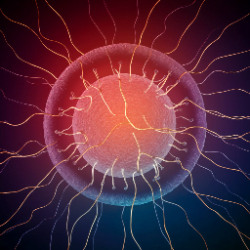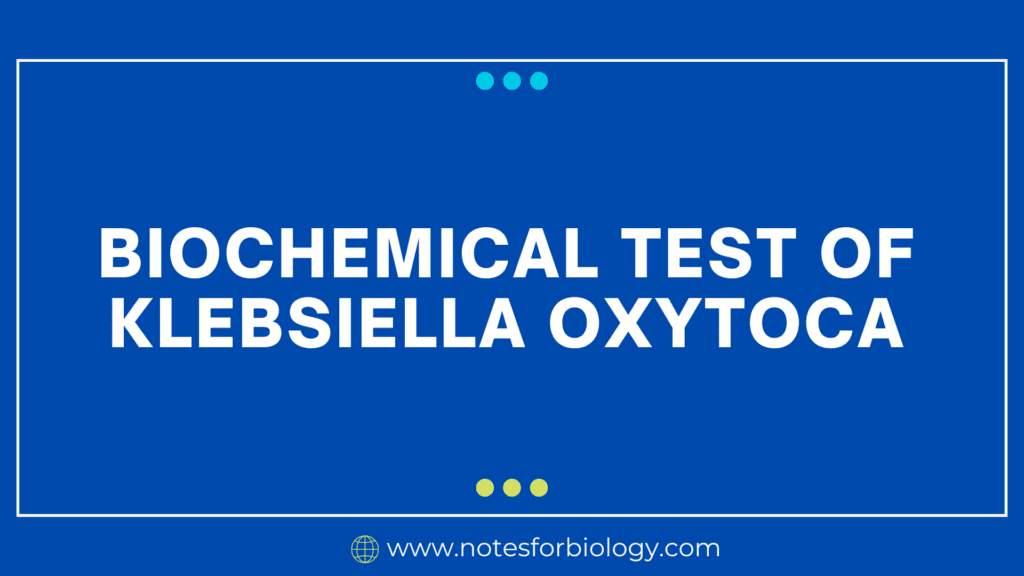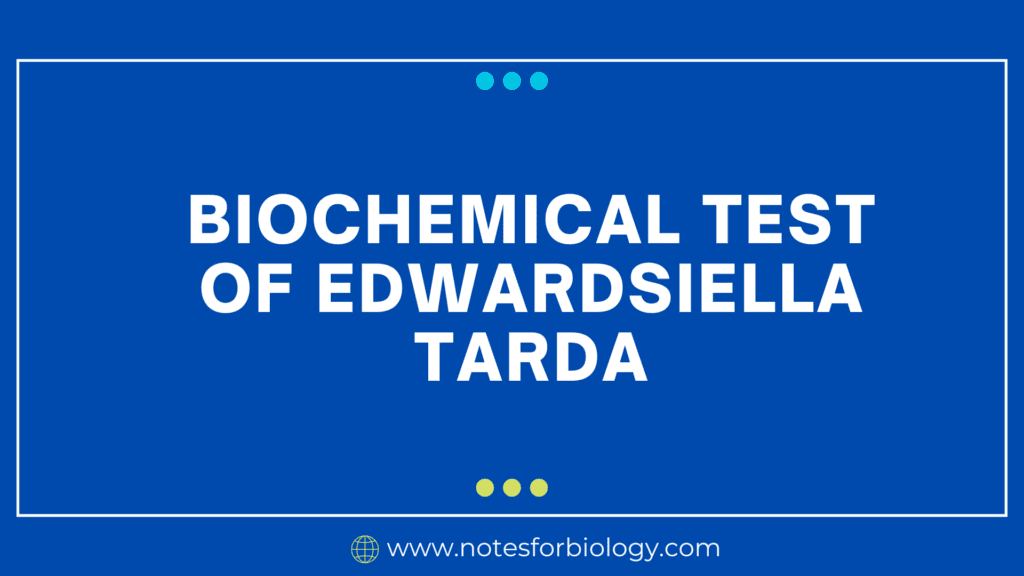The rod-shaped, gram-negative bacterium Klebsiella oxytoca belongs to the Enterobacteriaceae family. Although it is closely related to Klebsiella pneumoniae, some biochemical tests can be used to distinguish between the two.

Table of Contents
1. Gram Staining in Biochemical Test of Klebsiella oxytoca

One of the most important first steps in identifying and differentiating bacteria, including Klebsiella oxytoca, is gram staining. It is a basic staining method that offers crucial information on the shape and cell wall structure of bacteria, rather than a biochemical test in and of itself.
Gram Staining Procedure
- Preparing a Smear: A little piece of Klebsiella oxytoca is spread out across a microscope slide to create a thin layer.
- Fixation: The bacteria are adhered to the slide by passing it through a flame.
- Crystal violet primary stain is applied to the slide and allowed to sit for approximately one minute.
- After that, the slide is treated with iodine, a mordant that helps the crystal violet stick to the cell wall by forming a complex with it.
- Alcohol/acetone decolorization: An alcohol or acetone decolorizing agent is administered. Gram-positive and Gram-negative bacteria are distinguished in this stage. The thin peptidoglycan layer of gram-negative bacteria loses the crystal violet-iodine combination following decolorization.
- Lastly, the slide is counterstained with safranin, which leaves behind stains.
Interpretation for Klebsiella oxytoca
- Gram-negative rods as a result
- Klebsiella oxytoca appears as pink/red rod-shaped cells under a microscope.
- Reason: During the decolorization stage, the outer membrane and the thin layer of peptidoglycan on Klebsiella oxytoca do not hold onto the crystal violet stain. Under a microscope, the cells look pink or red as a result of taking up the counterstain, safranin.
2. Oxidase Test in Biochemical Test of Klebsiella oxytoca
A biochemical test called the oxidase test is performed to find out whether bacteria have the enzyme cytochrome c oxidase. This enzyme aids in the reduction of oxygen to water and is a crucial link in the electron transport cycle.
Oxidase Test Procedure
- Sample Preparation: Using a sterile loop or swab, a little quantity of bacterial colony is extracted.
- Application: The sample is applied directly to the surface of an oxidase test strip or disk, or it is put on a sheet of filter paper.
- Reagent Addition: The sample is mixed with a few drops of tetramethyl-p-phenylenediamine dihydrochloride, the oxidase reagent.
- Observation: A color shift is monitored in the region where the reagent was administered.
Interpretation for Klebsiella oxytoca
- Outcome: Negative Color Change (the reagent either stays colorless or becomes slightly gray)
- Justification: Since Klebsiella oxytoca does not generate cytochrome c oxidase, the reagent does not oxidize; if the enzyme were present, the reagent would become dark purple or blue.
3. Catalase Test in Biochemical Test of Klebsiella oxytoca
The catalase test is a biochemical experiment that’s used to find out if bacteria have the catalase enzyme. The breakdown of hydrogen peroxide by catalase results in the production of water and oxygen, which may be seen with the development of bubbles.
Catalase Test Procedure
- Sample Preparation: Using a sterile loop or swab, a little sample of a bacterial colony is extracted.
- Reagent Addition: On a microscope slide, a drop of 3% hydrogen peroxide (H2O₂) is applied.
- Application: On the slide, the hydrogen peroxide and bacterial sample are combined.
- Observation: Bubble development on the slide is monitored.
Interpretation for Klebsiella oxytoca
- Positive Outcome: Immediately after combining the bacteria with hydrogen peroxide, there will be bubbling or foaming.
- Reason: The enzyme catalase, produced by Klebsiella oxytoca, catalyzes the conversion of hydrogen peroxide into water and oxygen, causing bubbles to develop that are visible to the naked eye.
4. Lactose Fermentation on MacConkey Agar in Biochemical Test of Klebsiella oxytoca
One popular biochemical test to detect and distinguish Enterobacteriaceae based on lactose fermentation is the lactose fermentation test on MacConkey agar. In order to separate and distinguish Gram-negative enteric bacteria according to lactose fermentation, MacConkey agar is a selective and differential medium.
Lactose Fermentation Procedure on MacConkey Agar
- Inoculation: The surface of MacConkey agar is streaked with the bacterial sample, in this instance Klebsiella oxytoca.
- Incubation: For 18 to 24 hours, the agar plate is incubated at 35 to 37°C.
- Observation: The colony development and color shift on the plate are checked.
Interpretation for Klebsiella oxytoca
- Result: Lactose fermentation is positive.
- Appearance: Because acid production lowers pH and causes the neutral red indicator to become pink/red, colonies appear pink to red and frequently have a pink halo surrounding them.
Why? Because Lactose is fermented by Klebsiella oxytoca, acidic byproducts are produced. The pH indicator’s color changes as a result of these byproducts lowering the medium’s pH.
5. Indole Test in Biochemical Test of Klebsiella oxytoca
The indole test is a biological experiment designed to ascertain if bacteria can convert the amino acid tryptophan into indole. The Enterobacteriaceae family of tests is distinguished by the IMViC series of tests (Indole, Methyl Red, Voges-Proskauer, and Citrate tests).
Indole Test Procedure
- Inoculation: A tryptophan-rich tryptone broth is inoculated with a bacterial colony (Klebsiella oxytoca) in a tube.
- Incubation: For 24 to 48 hours, the tube is incubated at 35 to 37°C.
- Reagent Addition: Kovac’s reagent, which contains p-dimethylaminobenzaldehyde, is added to the tube following incubation.
- Observation: The broth’s surface is checked for the development of a red or pink layer on the tube.
Interpretation for Klebsiella oxytoca
- Positive Outcome: After adding Kovac’s reagent, a coating of reddish-pink color appears on the broth’s surface.
- Justification: Tryptophan may be hydrolyzed by Klebsiella oxytoca to produce ammonia, pyruvate, and indole. A reddish-pink chemical is created when the indole and p-dimethylaminobenzaldehyde in Kovac’s reagent combine.
6. Methyl Red (MR) Test in Biochemical Test of Klebsiella oxytoca
A biochemical test called the Methyl Red (MR) test is used to determine if bacteria can ferment glucose to form stable acidic end products. The Enterobacteriaceae family of tests is distinguished by the IMViC series of tests (Indole, Methyl Red, Voges-Proskauer, and Citrate tests).
Methyl Red (MR) Test Procedure
- Inoculation: MR-VP (Methyl Red-Voges-Proskauer) broth containing glucose is infected with a bacterial colony (Klebsiella oxytoca).
- Incubation: For 48 hours, the tube is incubated at 35–37°C.
- Reagent Addition: Five to six drops of methyl red indicator are added to the tube following incubation.
- Observation: A color shift in the tube is monitored.
Interpretation for Klebsiella oxytoca
- The outcome is uncertain. (Typically Negative)
- Look:
- Positive: A pH of 4.4 or below is indicated by the medium becoming red.
- Negative: A pH higher than 4.4 is indicated by the medium staying yellow or becoming orange.
- Reason: Normally, Klebsiella oxytoca does not digest glucose sufficiently to create enough stable acidic end products to keep the pH low. Consequently, the test frequently returns a negative or marginally positive result.
7. Voges-Proskauer (VP) Test in Biochemical Test of Klebsiella oxytoca
The biochemical assay known as the Voges-Proskauer (VP) test is used to find acetoin, a neutral byproduct of the fermentation of glucose. The Enterobacteriaceae family of tests is distinguished by the IMViC series of tests (Indole, Methyl Red, Voges-Proskauer, and Citrate tests).
Voges-Proskauer (VP) Test Procedure
- Inoculation: A bacterial colony (Klebsiella oxytoca) is inoculated into a tube containing MR-VP broth, which contains glucose.
- Incubation: The tube is incubated at 35-37°C for 24-48 hours.
- Reagent Addition: After incubation, 0.6 mL of alpha-naphthol (VP reagent A) is added to the tube, followed by 0.2 mL of potassium hydroxide (VP reagent B).
- Mixing: The tube is shaken vigorously to ensure oxygenation and mixed thoroughly.
- Observation: The tube is observed for up to 60 minutes for the development of a red color.
Interpretation for Klebsiella oxytoca
- Positive Outcome: After the reagents are added and mixed, the medium takes on a red tint.
- Justification: Acetoin is the intermediate product of the fermentation of glucose by Klebsiella oxytoca. Acetoin is changed into diacetyl in the presence of oxygen and in an alkaline environment. Diacetyl then combines with alpha-naphthol to generate a reddish-brown tint.
8. Citrate Utilization Test in Biochemical Test of Klebsiella oxytoca
A biochemical test called the citrate utilization test is performed to find out if bacteria can use citrate as their only source of carbon. The Enterobacteriaceae family of tests is distinguished by the IMViC series of tests (Indole, Methyl Red, Voges-Proskauer, and Citrate tests).
Citrate Utilization Test Procedure
- Inoculation: Using a sterile inoculating loop, a bacterial colony (Klebsiella oxytoca) is streaked across the surface of Simmon’s citrate agar slant.
- Incubation: For 24 to 48 hours, the infected tube is incubated at 35 to 37°C.
- Observation: The tube is checked to see if the medium has changed color.
Interpretation for Klebsiella oxytoca
- Positive Aesthetic Outcome: The medium turns blue instead of green.
- Justification: The only carbon source available to Klebsiella oxytoca is citrate. An alkaline environment results from the bacteria’s conversion of citrate into oxaloacetate and acetate, which are then further metabolized. The bromothymol blue indicator turns blue as pH rises from green.
9. Urease Test in Biochemical Test of Klebsiella oxytoca
A biochemical test called the urease test is performed to find out whether bacteria have the urease enzyme. The hydrolysis of urea into ammonia and carbon dioxide is catalyzed by urease, raising pH levels. This test is frequently used to distinguish between various types of bacteria according to how well they can make urease.
Urease Test Procedure
- Inoculation: Using a sterile inoculating loop, a bacterial colony (Klebsiella oxytoca) is streaked over the urea agar surface.
- Incubation: For 24 to 48 hours, the infected agar plate or tube is incubated at 35 to 37°C.
- Observation: A color shift is looked for on the plate or tube.
Interpretation for Klebsiella oxytoca
- Positive Outcome: The medium’s hue shifts from yellow to pink or magenta.
- The enzyme urease, which is produced by Klebsiella oxytoca, hydrolyzes urea to create ammonia and carbon dioxide. When ammonia is produced, the medium’s pH rises and the pH indicator (phenol red or bromothymol blue) turns from yellow, which indicates acidity, to pink or magenta, which indicates alkalinity.
10. Triple Sugar Iron (TSI) Agar Test
A biochemical test called the Triple Sugar Iron (TSI) agar test is used to distinguish between Enterobacteriaceae based on their capacity to ferment sugars, generate hydrogen sulfide (H2S), and create gas. This test helps with the identification and categorization of bacteria by providing important information about their fermentation processes.
TSI Agar Test Procedure
- Inoculation: Using a sterile inoculating loop, a bacterial colony (Klebsiella oxytoca) is smeared across the surface of a TSI agar slant.
- Incubation: For 18 to 24 hours, the infected slant is incubated at 35 to 37°C.
- Observation: A number of signs are looked for in the tilt.
Interpretation for Klebsiella oxytoca
- Sugar Fermentation:
- Glucose: Fermented, as seen by the butt of the slant turning yellow.
- Lactose and sucrose: These are usually fermented, as seen by the medium turning yellow in the slant and butt or throughout.
- Gas Production: Bubbles in the medium or fractures or lifting of the agar indicate the presence of gas.
- Production of Hydrogen Sulfide (H2S): In the event that H2S is created, it combines with ferrous sulfate to generate ferrous sulfide, a dark deposit, in the slant’s butt.
- Overall Interpretation: Gas generation and no H2S production under acid/acid (A/A) conditions.
11. Motility Test in Biochemical Test of Klebsiella oxytoca
The motility test is a biochemical assay that’s used to measure how well bacteria may move or spread from the site of inoculation. This test is crucial for identifying bacterial species and comprehending how they behave in various settings.
Motility Test Procedure
- Inoculation: Using a sterile inoculating needle or loop, a bacterial colony (Klebsiella oxytoca) is stabbed or streaked into a semisolid media like motility agar.
- Incubation: The infected agar plate or tube is incubated for 24 to 48 hours at the proper temperature, which is typically 35 to 37°C.
- Observation: The plate or tube is checked to see if growth is emanating from the injection site or not.
Interpretation for Klebsiella oxytoca
- Finding: Unfavorable (non-motile)
- Appearance: There is no discernible spreading or radiating growth from the place of inoculation; the growth is still contained inside the stab or streak line.
- Justification: In a semisolid substrate, Klebsiella oxytoca does not actively move or spread. It is a non-motile bacteria.
12. Ornithine Decarboxylase Test in Biochemical Test of Klebsiella oxytoca
The biochemical assay known as the ornithine decarboxylase (ODC) test is used to identify if bacteria contain the enzyme ornithine decarboxylase. One of the most important steps in the production of polyamines is the decarboxylation of ornithine to putrescine, which is catalyzed by ornithine decarboxylase. To identify and distinguish between various bacterial species, this test is frequently used in combination with other biochemical assays.
Ornithine Decarboxylase (ODC) Test Procedure
- Inoculation: Using a sterile inoculating loop, a bacterial colony (Klebsiella oxytoca) is streaked across the surface of a medium, such as ornithine decarboxylase broth.
- Incubation: The infected medium is incubated for 18 to 24 hours at the proper temperature, which is typically 35 to 37°C.
- Observation: A color shift or other signs of ornithine decarboxylase activity are looked for in the medium.
Interpretation for Klebsiella oxytoca
- Result: Positive Appearance: The medium may exhibit obvious indicators of decarboxylation, such as turbidity or gas generation, or it may change color (typically from yellow to purple).
- Justification: Ornithine decarboxylase, produced by Klebsiella oxytoca, catalyzes the decarboxylation of ornithine to create putrescine. Visible alterations in the media may arise from this reaction, signifying that the ornithine decarboxylase activity test was successful.
Summary of Biochemical Test of Klebsiella oxytoca
Biochemical test of Klebsiella oxytoca includes testing for the production of indole, citrate utilization, urease activity, and fermentation of glucose, lactose, and sucrose. These tests help in the identification and differentiation of Klebsiella oxytoca from other bacteria.
Biochemical Test of Klebsiella oxytoca is a gram-negative bacterium that can cause infections in humans, particularly in individuals with weakened immune systems. Biochemical tests of Klebsiella oxytoca can be performed to help identify and differentiate biochemical test of Klebsiella oxytoca from other bacterial species. One common test is the oxidase test, which involves adding a reagent to a bacterial sample and observing for the presence of an enzyme called cytochrome oxidase. Biochemical test of Klebsiella oxytoca is typically negative for this enzyme.
Frequently Asked Question
1. How do you identify Klebsiella oxytoca?
The indole reaction, which is positive in K. oxytoca and negative in K. pneumoniae, is the only way to distinguish between K. oxytoca (3). To detect K, one reliable, sensitive, and specific method is the polymerase chain reaction (PCR).
2. What is the lab test for Klebsiella?
Collect a sample of sputum for Gram staining. Gram-negative bacilli that are short and fat are known as Klebsiellae. Usually, a capsule that resembles a clean area surrounds them. Finding out if you have a Klebsiella infection is not possible using serology findings.
3. Is Klebsiella oxytoca aerobic or anaerobic?
Under microaerobic circumstances, the facultative anaerobe Klebsiella oxytoca—previously categorized as K. pneumoniae (26—can convert glycerol into 1,3-propanediol (27, 28).
Related Article



